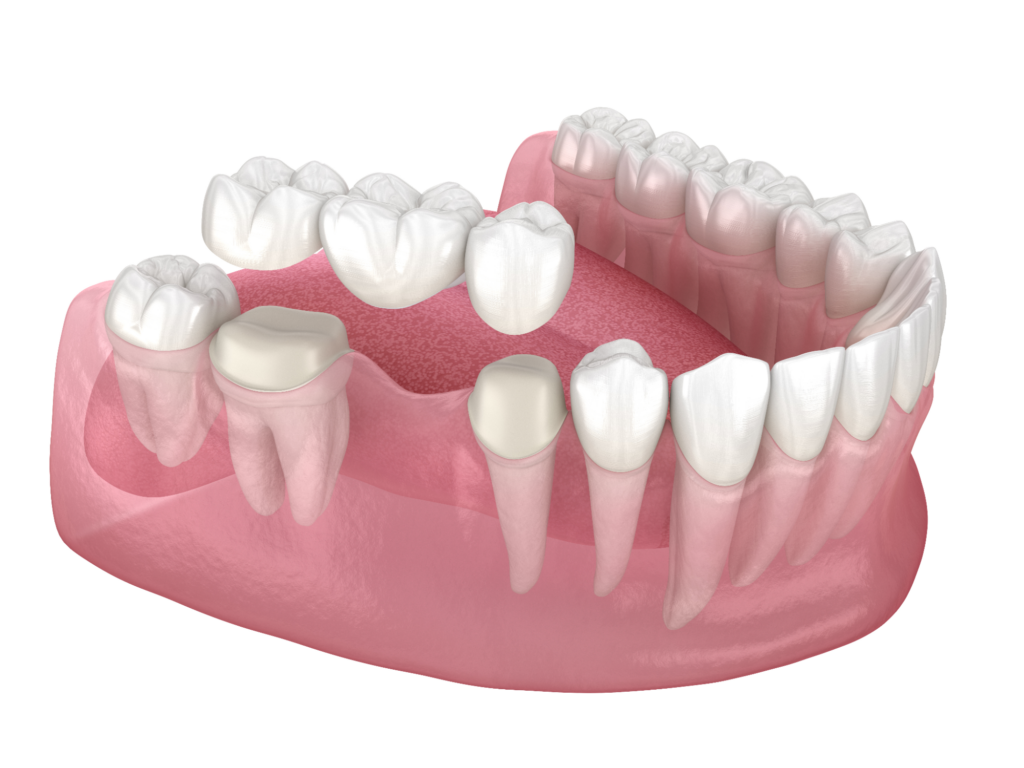Are you missing teeth? If you’re tired of hiding your smile or not being able to chew correctly due to a gap in your teeth, there are solutions. One of which is a dental bridge. For anyone who has one or more missing teeth, a dental bridge can help restore your smile.
With a whopping one-quarter of Australians suffering from tooth decay which, if left untreated, can result in tooth loss or removal, it’s not at all surprising that the need for dental bridges has increased.
What Is a Dental Bridge?
A dental bridge is just that; a bridge over the gap of your missing tooth or teeth. The bridge uses crowns on the anchoring teeth and provides a bridge with one or more false teeth to fill in the space where your missing teeth once were. This can be a good option if you don’t want to get implants.
There are three main types of dental bridges, including:
Traditional: A crown is applied to the two teeth on either side of the gap, and porcelain or ceramic fake teeth are used to fill the gap.
Cantilever: A cantilever is designed for the fake tooth to be anchored to one tooth only by placing a crown on this tooth. While there is less support to anchor the fake tooth than a traditional bridge, a cantilever bridge can be appropriate in some circumstances.
Maryland bonded: This is a specific type of cantilever bridge where, rather than crowning the anchoring adjacent tooth to the gap, a metal arm is bonded to the inside of this adjacent tooth. A porcelain or ceramic fake tooth is then attached to the arm. This is often a great option because it is the most conservative type of bridge, as it requires the least amount of tooth structure removal. This is thanks to the special cement used to hold it in place.
When you visit with us, we can recommend the best type of dental bridge to suit your individual needs.
What Happens During a Dental Bridge Procedure?
The procedure generally involves two visits. On the first visit, the dentist will take an impression of your teeth so that the bridge can be created. A temporary bridge will be put into place in the meantime.
Your abutment teeth, or the teeth on either side of the gap, will be prepared for the bridge. This means the dentist needs to grind away part of the enamel and dentin to shape the abutment teeth correctly. The temporary bridge will help prevent damage to the newly prepped teeth and will keep them in prime condition for when the permanent bridge is installed.
On the second visit, the temporary bridge will be taken out and the permanent one will be fitted into place. The dentist will check that you are comfortable and can chew properly with the bridge in place. Any adjustments that need to be made will be made at this point so you can go home feeling great and ready to take on the world.
When Do You Need a Dental Bridge?
You are only eligible for a dental bridge in specific circumstances, so not everyone will have the option of getting one. In order for your dentist to agree to give you a dental bridge, you’ll need to meet a few criteria.
These include:
- One or more permanent teeth missing.
- Strong adjacent teeth will be used to anchor the fake tooth.
- Otherwise good oral and physical health.
- Ability to maintain the dental bridge with good oral hygiene.
If you do meet the criteria, you can talk to your dentist about the options and decide on the best solution for you.
A missing tooth can cause a number of dental problems and by using a bridge, you can improve your chewing function and smile.
How Do You Care For Your Dental Bridge?
Although proper dental hygiene throughout your life is important, when you have a dental bridge it’s incredibly important that your hygiene practices are maintained. Being diligent about your dental hygiene will ensure you take care of your remaining teeth and ward off cavities.
So what should you do to take good care of your bridge and your teeth?
See a dentist for cleanings. You should book regular cleanings with your dentist, as they have the tools to get into the places your toothbrush and floss can miss. Your dentist will also note if any potential issues need to be addressed. In most cases, you can prevent bigger problems by treating dental issues early on.
Brush and floss. You should brush your teeth at least twice a day or after every meal. It’s also important to floss. While you can use dental floss on your bridge, you’ll want to look for a threader that will make it much easier to floss between your bridge and other teeth.
Eat properly. Your diet affects your teeth, so you should stick to healthy foods and avoid overly sugary foods. Adjusting your diet can help preserve the health of your teeth for longer. Avoid foods that are overly sticky or hard, as these may dislodge or fracture the bridge.
How Long Does a Dental Bridge Last For?
The longevity of your dental bridge depends heavily on how well you look after it. However, when properly cared for, your dental bridge may last anywhere from 5 to 20 years.
Summary
If you’re missing teeth and feel like it has affected your speech, self-esteem and ability to eat, you can easily resolve this by talking to your dentist. A dental bridge can give you back the confidence you’ve lost and allow you to do the things you love once again.
As long as you look after your bridge and the general health of your teeth, your bridge should last many years.
Book an appointment today for the professionals at The Dental Family Beaumaris to help you find the dental bridge that best suits your oral health needs.


